Sailing Triumphs and Crashes
Charlotte Harbor is a great place for sailors! With more than 80 square miles of water, it is large enough to sail in new areas all day, but small enough that protection is never far away. I got the word through the Punta Gorda Sailing Club that Brian Gleason and the Charlotte Harbor Regatta board were asking for volunteers to serve aboard race committee boats. I contacted them and told them I could serve, and use my 15' Boston Whaler to set race marks or as a safety boat if needed.
They had plenty of boats, so asked me to be aboard the race signal boat. For those who don't race sailboats, the signal boat marks one end of the start/finish line in these races, so I was guaranteed a seat right where some important action takes place.
When I got the duty roster, I noticed my name in one place: on Saturday. Friday morning I thought I should contact the skipper and ask where I should be, and when. I took another look at the schedule and noticed that I was also supposed to be aboard the signal boat Friday at 9:00! It was 8:26! I quickly called the skipper, who had already left the dock. Oops! I grabbed my waterproof camera, wallet, and a bottle of water and raced out the door, catching a ride aboard one of the mark setting boats to get out where I was supposed to be. The boat I was aboard was an Albin 32, almost identical to this Albin 322, except for the integral swim platform.
|
The harbor was already filled with sails by the time I stepped aboard, and the Coast Guard Auxiliary boat came by to check in with us and make sure that we knew their working radio frequency, and they knew ours. With a lot of small boats sailing around the harbor very fast, it was likely a few people would go for an unplanned swim when their sailboats capsized. |
|
|
The Viper 640's started to come by to check in with us, including some teams of very experienced racers. |
|
|
And a couple of racing families with ten year olds in the crew roster. Look at that smile! |
Though I have spent a little time racing various sailboats, I was not at all familiar with the details of life on the race committee signal boat. While the boats were checking in I chatted with the aging ex-Navy guys who were also serving as volunteers, and we all attempted to stay out of the way of our skipper, Jeff, who was running around setting things up.
The first question to answer in setting up a sailboat race course is, "What is the direction and speed of the wind?" Jeff has a portable wind instrument mounted on a pole on his bow rail, and with a built in electronic compass it reads the wind speed and direction, using a running 6 second average to smooth out variations in the readings.
Once the wind direction was determined, Jeff directed the mark boat to place the upwind mark 9/10 of a mile directly upwind of the signal boat. With that mark in place, Jeff turned his attention to the pin boat, whose job was to set the leeward mark just off our bow, and then to set the "pin" mark on the other end of the starting line, which is placed perpendicular to the wind direction and far enough from the signal boat to allow the racers room to start, but close enough to sort of pack them together. Obviously, the exact distances and angles of these marks can only be determined after the signal boat is in position, and the wind direction and speed are known.
With the course in place, Jeff set up an official race clock where we could all see it, but racers could not, and explained to us the operation of his countdown timing device. Before a sailboat race, the signal boat sounds a 5 minute warning horn and puts up the flag of the fleet that is to start, giving the racers notice to get in position near the line. At 4 minutes to start, another horn sounds, and a "Papa" (P for preparatory) flag is flown. At one minute to start, the Papa flag comes down with another horn blast, and when it is time to actually start the race, the fleet flag comes down as the starting horn sounds.
It is important that the crew on the signal boat get these signals right and do them precisely on time, so Jeff had a neat device that would beep to warn us when there was an impending flag signal required, and would automatically sound the horn. As the race starts, our eyes need to be focused on the starting line, to call out the sail numbers of any boat across the line before the signal. One crewman on the signal boat is standing by with the individual and fleet recall flags, in case they are needed.
|
First to start were the S2 7.9 class, seen here jockeying for position a minute or so before the start of their race. |
|
|
Coming across the line with a strong start that presaged their dominance throughout the day was a local boat, Bama Slammer, always a strong competitor in Punta Gorda Sailing Club races. Notice that the bow men on the other two boats are still forward skirting their jibs inside the lifelines, but Bama's bow woman is already seated on the rail, her job complete. |
|
|
The other two boats chased Bama Slammer all day, but couldn't quite catch up. We saw this same scene on the downwind legs, four races in a row. |
Meanwhile, with the S2's on their way sailing up the course, we on the signal boat were working the flags for the start of the Viper 640 class race. The pro's were obviously running through a choreographed pre-start sequence they had honed to a fine point, and it was fun watching them come head-to-wind on the line, check the actual wind on the line, then zip off in one direction or another on a timed run to get in position for the start. In this video, you can see a Viper 640 class start and in the background hear the beeps and horns from the timing device aboard the signal boat. One of the boats crossed the line early. The video also shows the finish of one of the races, including one Viper that ran out of finish line and had to jibe close to the signal boat, right in front of my camera. Those little sport boats look really fast and fun!
While the two fleets were off on the race course, race management continues aboard the signal boat. We stayed in contact with the mark boat, which stayed up near the windward mark, to ascertain when all of the boats had rounded the mark for the last time. This allows a window of time before the next race during which the windward mark could be repositioned if the wind changed between races, which it did. They had to move the mark a short distance. We were also talking to the pin boat, which had to reset the other end of the start/finish line so as to keep it perpendicular to the wind direction.
Other than that, life on the signal boat was pretty relaxed during the races. I listened to the Navy guys exchange stories and had a sandwich, thinking about those racers out there who had to try to find a moment to gulp down a granola bar to keep hunger at bay. I also took the opportunity to take a lot of pictures and videos of the sailboats as they raced. This one shows a rare moment when S2 7.9 "Soulshine" led eventual winner "Bama Slammer" around the leeward mark, with the two boats simultaneously dousing their spinnakers just before reaching the mark.
Some pictures of the boats racing on Friday:
|
A Viper 640 throws off spray as it blasts through the chop. |
|
|
A Viper 640 finishing next to the signal boat. |
|
|
A Viper 640 tearing across the harbor. |
|
|
Viper 640 reaching to finish under asymmetric spinnaker. |
|
|
A Viper 640 fleet starting up the course. |
|
|
Two Vipers crossing under asymmetric spinnakers. |
|
|
Five Vipers blasting down the course toward the signal boat. |
|
|
Two S2 7.9 Sailboats running close under spinnakers, while a third lags a short distance behind, barely ahead of the Viper 640 class power reaching up from behind. |
|
|
An S2 beats upwind while in the background a Viper reaches downwind. |
|
|
There was enough wind to make life interesting for the sailors, and one Viper 640 crew briefly lost control of their boat. |
Here is a short video of the Viper 640s racing, along with S2 7.9 "Crime Scene" which was not quite fast enough to finish ahead of the Viper fleet.
As the boats finished the race, our job on the race committee boat was to keep track of the sail numbers and the order in which they finished. I learned that from the perspective of the watchers, a Viper 640's sail number is not visible when they are reaching toward the finish line. It is completely obscured by the spinnaker. Unless the number is also on the spinnaker, you have to catch it when they jibe or it will only be visible once they are crossing the line. If a pack of them cross at once, the sail numbers can be obscured by another boat. In our club races, everyone knows all the boats, and they're generally called by name and not sail number. There is never any question about which boat is over there finishing beyond the boat finishing alongside the signal boat. In our small fleets, we did not have any problem figuring out who was who, but I can see how it would be difficult in some of the big class races to figure out who finished where in a pack. Once all the boats were finished racing 4 races, we radioed in the results and headed back to the dock. My truck was still stuck where I had met the mark boat, but it happened to be at Bill's neighbor's house so I just went home with him. Life is good like that in Punta Gorda, and what a great day on Charlotte Harbor!
|
The following day, Saturday February 6, 2010 started a lot more smoothly for me. I brought along my Canon ZR 800 miniDV camcorder, so my waterproof Canon Powershot D10 did not have to serve double duty as still camera and video camera. I got over to Fisherman's Village marina a little early, which sure beat the panic dash to catch the mark boat the day before! We cast off just after 8 to go out to set our course area, and as we were heading across the harbor the wind started to pipe up. I was wishing I had a drysuit, so I could sail my Hobie Adventure Island out on Charlotte Harbor on days like this without freezing. I knew the racers were going to have a great day for competition. Winds were fairly strong out of the northwest, with nasty, sharp little puffs gusting through, usually accompanied by a swing to the north in wind direction. Late in the day, I asked Jeff what his fancy wind instrument had measured for Saturday, and he told me we were recording 20-22 knots of sustained winds, with a peak recorded gust of 25 knots. We anchored the signal boat a half mile or so southwest of Charlotte Harbor marker #2 in this picture. |
|
|
The mark boat set the windward mark for our course about 7/10 of a mile upwind of our position, and the pin boat put out the turning mark and the starting line buoy. The boats came by to check in, with many of the Vipers sailing out of Fisherman's Village and coming on a fast reach from the upper harbor. |
|
|
We had fewer boats check in, with the Vipers crewed by kids wisely electing to stay on the dock in the strong wind conditions. Once again the S2's started first, with Bama Slammer getting an uncharacteristically bad start. |
|
|
As the S2s worked their way up the course, the Viper 640 fleet started their race, with a whole lot of fluttering luffing sails. Their powerful main sails seemed to be providing too much power in the strong and gusty winds, and in a few cases, it turned bad. This was the last start for 3 of these masts. |
Charlotte Harbor is shallow and well protected, with only a few miles of fetch in most wind conditions and an average depth of about 12 feet. When it gets choppy, the waves are steep and close together, making them difficult for the light Viper 640 class, and not much easier on the S2 fleet. We had some time to kill on the signal boat as the racers fought their way upwind against the whitecaps. The guys I was crewing with turned out to be fascinating and fun characters. One of them, Jay, served aboard a minesweeper, and told us about drills they would do in which they planted and recovered dummy mines. At least, they got most of them! He told us about one mine that was lost, then recovered a few years later, after the area had been seeded with mines and swept in the annual drill each year. He said the mines would detect the electromagnetic signature of a ship and detonate, and one of his responsibilities was to ensure their ship's signature was low.
I knew that minesweepers were made of wood, but he said most of the metal parts used to assemble the wood were monel, thus both corrosion resistant and non-magnetic. I asked why the mine did not just sense the engines and blow them all to kingdom come. Aluminum engine blocks and more monel and other non-ferrous material is used for everything mechanical on the boats. Interesting stuff, then Bill, a former Navy Corsair combat pilot, told us about flying off the carrier. He said that in tight quarters, they would tie down a few Corsairs on the forward flight deck on either side, with the rows of airplanes facing inward. They could effectively turn the ship by simultaneously throttling up a few 16 foot propellers on one side of the ship, while directing the ones on the opposite side to power down. A 900 foot airboat!
|
What's that, the mark boat calling, telling us that the S2s are at the mark? Right, the regatta! I grabbed my cameras, thinking it would probably get interesting if the S2s put out their spinnakers. I had raced on one of the S2 7.9s in conditions like these, and we did very well downwind by just leaving our spinnaker in the bag and heading downwind as the rest of the fleet wiped out around us. None of the boats seemed to think the extra power of the spin would be necessary that day. They were coming back down wing on wing under main and jib. |
|
|
Pretty soon the Vipers started to round the windward mark, and I knew that they would be flying back down the course in these conditions. Before they really got close to us, I heard a rather exasperated voice on the radio. It was one of our Vipers, and he said they had lost their rig and needed assistance. A flurry of radio activity ensued, and I thought to myself that it was a good thing we had plenty of powerboats out on the harbor. With those Vipers zooming all over the place on wider reaching angles than the S2's, we had boats scattered over a pretty good sized area. |
|
|
Considering that the other two fleets also had some boats in various kinds of trouble, with Hobie Cats flipping and cartwheeling all over the harbor, it suddenly seemed that we might not have plenty of safety boats after all. Our mark boat went to help the boat in trouble, but what if another one got in trouble? |
|
|
Well, another one did get in trouble. I was watching a pair of Vipers just raging along, and concentrating on trying to hold my video camera still as I focused in on them. One had a green spinnaker, the other was white. The green boat started to get in trouble, and I zoomed in closer on it. I could see the crew climbing over the windward side as the boat blew onto its side. I glanced away from the camera monitor for a moment to check on the white boat and its mast was broken. I told our skipper so he could direct rescue boats to that one, but I'm pretty sure they were already on the way. That one caught a ride home from one of our larger helper boats. |
|
|
The Viper with the green spinnaker quickly got back up and continued on their way. Meanwhile, a couple of Hobie Waves lost their way, and apparently spotted our turning mark and starting line pin. Not knowing where the mark was that they were supposed to round, they came over and rounded our marks instead. I think the Stars in the background of this shot were actually heading for the mark that these Hobies were supposed to round. |
|
|
The S2 7.9s coming down toward the finish were a lot less photogenic than usual, not flying their spinnakers. After they finished, a couple of S2s told us they were not interested in another race, though we were already preparing another start sequence for them. Can't say I blame them, though! |
|
|
Another Viper broke a mast after a while. With three Vipers down, two of the others decided to withdraw after completing the one race, leaving only race boat. They seemed disappointed that there would be no more racing. I was thinking these Viper 640 guys definitely flunked their sanity test, or perhaps just have an intense dislike for masts, with half the fleet having lost their rigs. It was a day when I would not be at all surprised to see someone break a rig, but three? In later discussions on Sailing Anarchy, I learned that the Viper 640 needs a lot of prebend in the mast in gusty conditions to prevent inversion. For those who don't speak "sportboat sailor" that means the mast is bent like a longbow and under a lot of tension. The mainsail is then able to hold up the top of the mast, as the boat has no backstay. If the mast is not bent enough, and the wind is strong enough, the mast will break in half. The problem with a lot of prebend in the mast is that it flattens the mainsail, making it less powerful. I suspect that the crew that wanted to keep racing knew their mast was safely bent for the conditions, while those who withdrew were not sure. As we were preparing to get under way, I was watching a small cruising sloop sailing nicely around the point of Punta Gorda under reefed main and roller reefed jib. It's good to see another sailor in this area who sees winds like these and wants to play with a sailboat! Our best sailing occurs in the summer when a tropical storm is near, but not too near, and the second best comes on February days like this one. It can be chilly but a lot of fun! That's why I was rather disappointed to look over at the sloop and see this. I knew it had to be my internet buddy, Catboat Willy, in his Marshall catboat, but his sail was down and covered! He should be eating that sloop UP under reefed megasail! As a fellow catboat owner, I thought it just wrong to take it out on a day like this and use it as a powerboat! I later asked him why he did that, and he explained that even with both reefs in the sail the boat was overpowered in the gusts, so he put away the sail. OK, CW, you get a pass on that one for at least giving it a shot and having the sense to know when to stop. |
|
|
Off in the distance as we retrieved the anchor, another Hobie 16 had capsized. They righted the boat, only to have it kind of cartwheel over again. On the next attempt, they got it up and pointed in a better direction and off they went again. They might just need to buy Hobie 16 parts soon... |
|
|
This Hobie 16 with the green sail was everywhere, zipping all over the harbor and entertaining us all day long. |
|
|
But they were not immune to the powerful gusts, and also capsized their boat at one point. No problem, just part of the fun of pushing beach cats hard on a gusty day. Tip them back up and blast off again! |
|
| On our way back, we detoured around a bit in the other two race courses, first being passed by the Hobe Wave fleet. The Wave is definitely a family toy, not a serious race boat, but don't tell that to the Hobie Wave class! Some really great sailors race these boats, and it was a perfect day for them to make the Waves really move! | |
| A couple of them were flying hulls. As multihullers say, one hull is fine, as long as you have more hanging in the air! | |
| As we approached Fisherman's Village, we got into the race course used by the Sunfish and Star fleets. They were up in the "protection" of the upper harbor, except that on a day like this one, all the waves in the harbor run full force into that area, broken up only by the reflections of previous waves bouncing back out. It's a choppy, sloppy mess, and these guys are out in Sunfish. | |
| Just being out in these conditions in a Sunfish is sort of taunting Mother Nature. | |
| And more than one of them paid for their insolence! |
I got some video of the fun and the mishaps of the S2 7.9s, Viper 640s, and other boats sailing in the Charlotte Harbor Regatta on Saturday, Feb 6, 2010
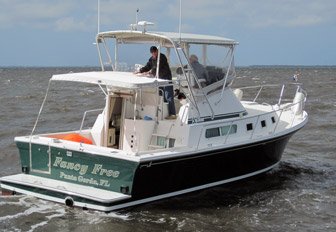
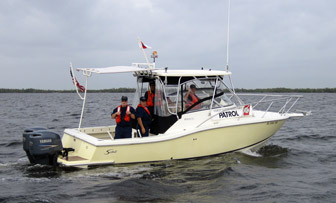
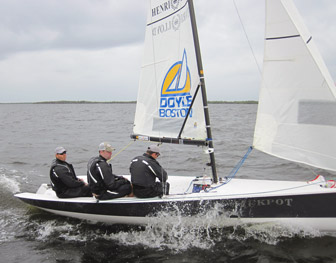
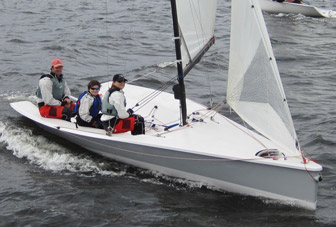
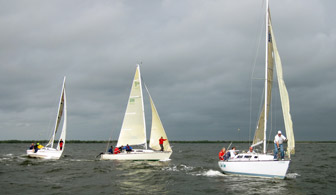
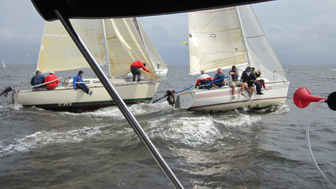
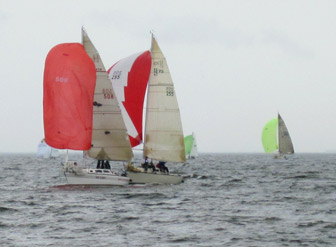
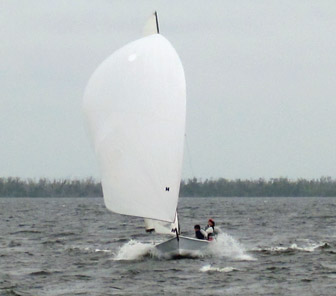
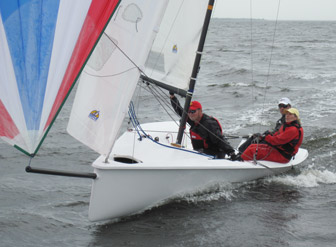
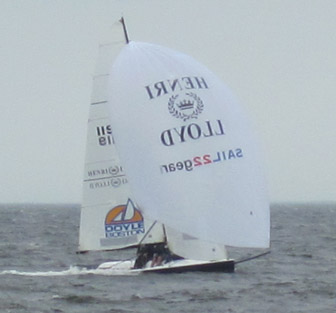
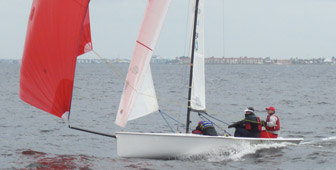
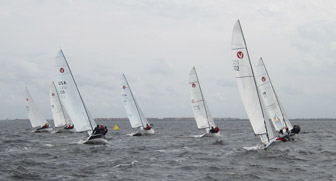
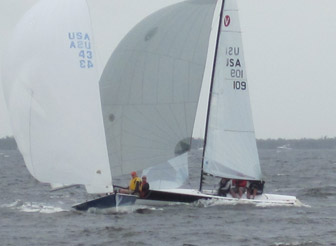
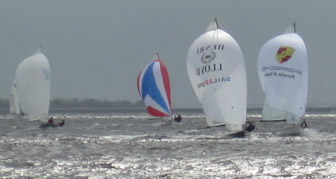
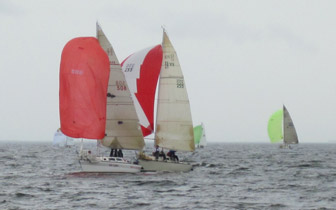
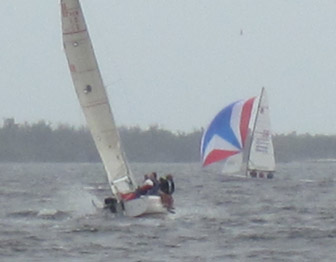
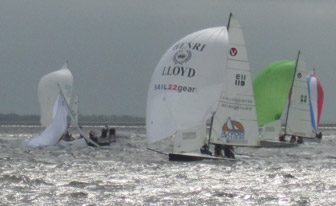
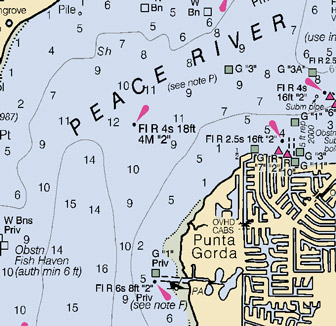
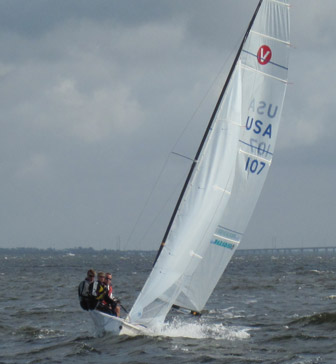
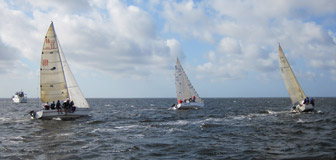
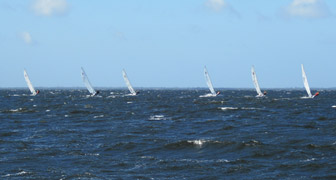
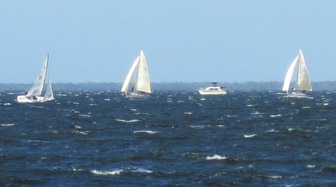
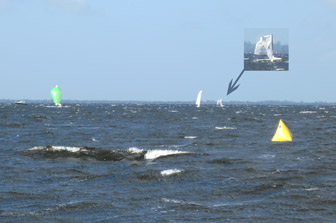

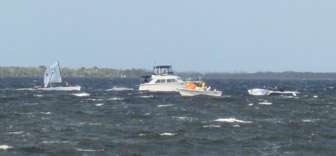
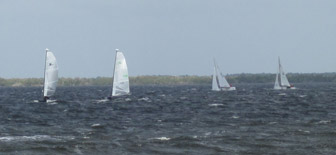
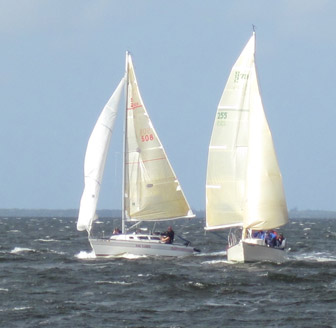
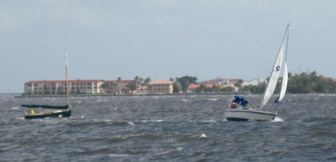
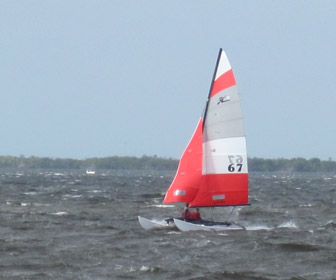
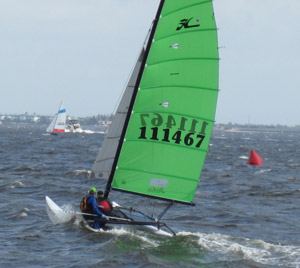
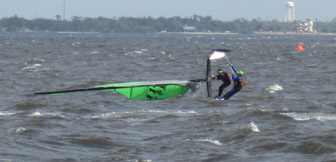
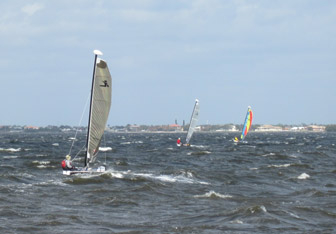
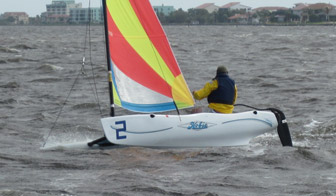
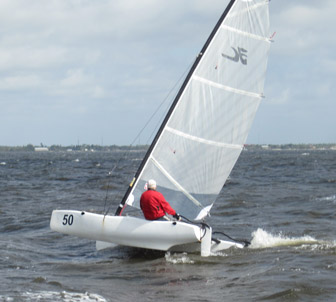
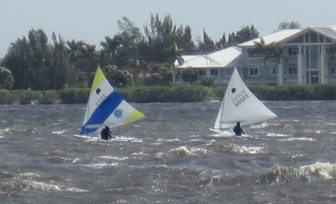
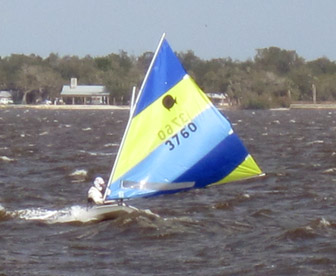

Leave a Reply
You must be logged in to post a comment.